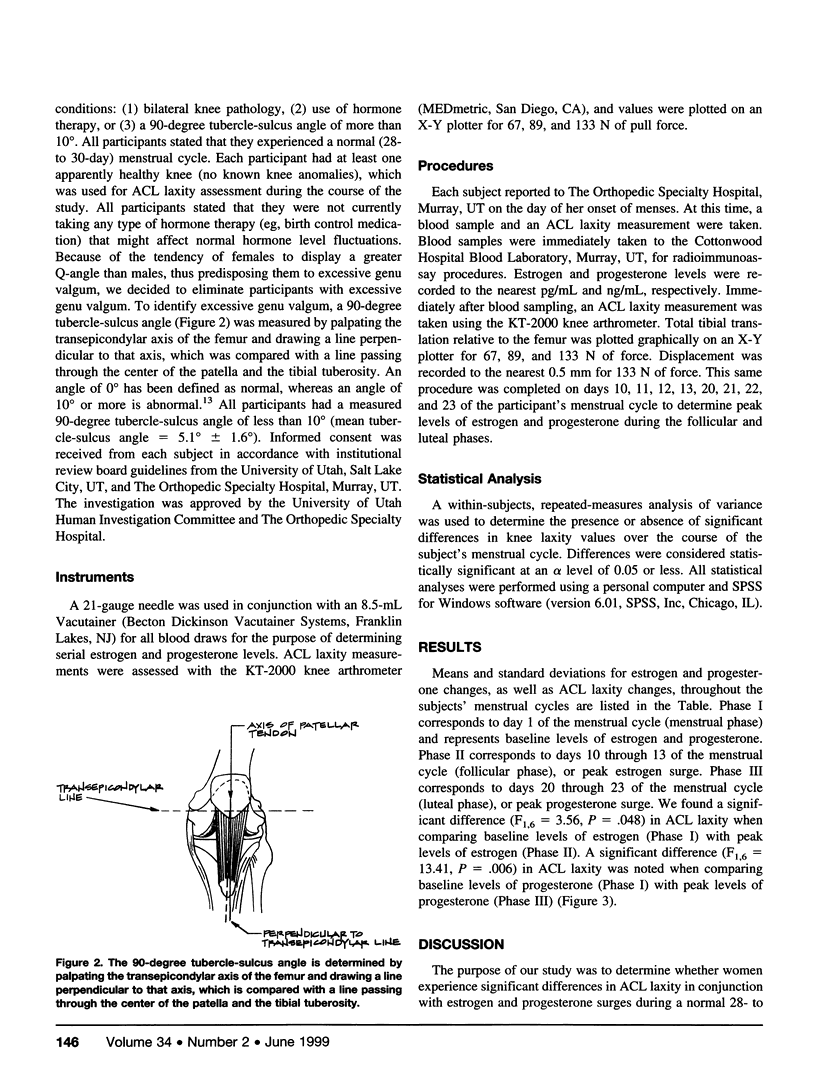Abstract
Objective:
To determine whether women experience significantly greater anterior cruciate ligament (ACL) laxity in conjunction with estrogen and progesterone surges during a normal 28- to 30-day menstrual cycle.
Design and Setting:
Serial estrogen and progesterone levels were measured via radioimmunoassay procedures to identify the follicular and luteal phases of a subject's menstrual cycle and to determine periods of peak hormonal surges. Concomitant ACL laxity measures were taken using a knee arthrometer. Hormone levels and ACL laxity were assessed on days 1, 10, 11, 12, 13, 20, 21, 22, and 23 of the menstrual cycle. Day 1 corresponds to the menstrual phase, when estrogen and progesterone levels are at their lowest. Days 10 through 13 correspond to peak estrogen surge (follicular phase), and days 20 through 23 correspond to peak progesterone surge (luteal phase).
Subjects:
Seven active females between the ages of 21 and 32 years with at least one apparently healthy knee (no known knee anomalies) volunteered for participation in this study. Each subject stated that she experienced a normal (28- to 30-day) menstrual cycle and was not currently taking any type of hormone therapy (eg, birth control medication).
Measurements:
Blood was drawn on days 1, 10, 11, 12, 13, 20, 21, 22, and 23 of each subject's menstrual cycle, and ACL laxity measurements were assessed immediately after the blood draws. Estrogen and progesterone levels were determined via radioimmunoassay procedures, and ACL laxity was determined using a knee arthrometer.
Results:
A within-subjects, repeated-measures analysis of variance was applied to determine the presence or absence of significant differences in ACL laxity values over the course of a subject's menstrual cycle. We found a significant difference in ACL laxity when comparing baseline levels of estrogen with peak levels of estrogen. A significant increase in ACL laxity was also noted when comparing baseline levels of progesterone with peak levels of progesterone.
Conclusions:
ACL laxity increased significantly throughout the menstrual cycle when comparing baseline with peak levels of estrogen and progesterone.
Keywords: estrogen, progesterone, knee arthrometer, radioimmunoassay
Full text
PDF





Images in this article
Selected References
These references are in PubMed. This may not be the complete list of references from this article.
- Beck J. L., Wildermuth B. P. The female athlete's knee. Clin Sports Med. 1985 Apr;4(2):345–366. [PubMed] [Google Scholar]
- Daniel D. M., Malcom L. L., Losse G., Stone M. L., Sachs R., Burks R. Instrumented measurement of anterior laxity of the knee. J Bone Joint Surg Am. 1985 Jun;67(5):720–726. [PubMed] [Google Scholar]
- DeHaven K. E., Lintner D. M. Athletic injuries: comparison by age, sport, and gender. Am J Sports Med. 1986 May-Jun;14(3):218–224. doi: 10.1177/036354658601400307. [DOI] [PubMed] [Google Scholar]
- DeHaven K. E., Lintner D. M. Athletic injuries: comparison by age, sport, and gender. Am J Sports Med. 1986 May-Jun;14(3):218–224. doi: 10.1177/036354658601400307. [DOI] [PubMed] [Google Scholar]
- Hutchinson M. R., Ireland M. L. Knee injuries in female athletes. Sports Med. 1995 Apr;19(4):288–302. doi: 10.2165/00007256-199519040-00006. [DOI] [PubMed] [Google Scholar]
- Johnson R. J. The anterior cruciate: a dilemma in sports medicine. Int J Sports Med. 1982 May;3(2):71–79. doi: 10.1055/s-2008-1026066. [DOI] [PubMed] [Google Scholar]
- Kolowich P. A., Paulos L. E., Rosenberg T. D., Farnsworth S. Lateral release of the patella: indications and contraindications. Am J Sports Med. 1990 Jul-Aug;18(4):359–365. doi: 10.1177/036354659001800405. [DOI] [PubMed] [Google Scholar]
- Liu S. H., Al-Shaikh R. A., Panossian V., Finerman G. A., Lane J. M. Estrogen affects the cellular metabolism of the anterior cruciate ligament. A potential explanation for female athletic injury. Am J Sports Med. 1997 Sep-Oct;25(5):704–709. doi: 10.1177/036354659702500521. [DOI] [PubMed] [Google Scholar]
- Liu S. H., al-Shaikh R., Panossian V., Yang R. S., Nelson S. D., Soleiman N., Finerman G. A., Lane J. M. Primary immunolocalization of estrogen and progesterone target cells in the human anterior cruciate ligament. J Orthop Res. 1996 Jul;14(4):526–533. doi: 10.1002/jor.1100140405. [DOI] [PubMed] [Google Scholar]
- Loumaye E., Depreester S., Donnez J., Thomas K. Immunoreactive relaxin surge in the peritoneal fluid of women during the midluteal phase. Fertil Steril. 1984 Dec;42(6):856–860. doi: 10.1016/s0015-0282(16)48256-7. [DOI] [PubMed] [Google Scholar]
- MacLennan A. H. The role of the hormone relaxin in human reproduction and pelvic girdle relaxation. Scand J Rheumatol Suppl. 1991;88:7–15. [PubMed] [Google Scholar]
- Markolf K. L., Graff-Radford A., Amstutz H. C. In vivo knee stability. A quantitative assessment using an instrumented clinical testing apparatus. J Bone Joint Surg Am. 1978 Jul;60(5):664–674. [PubMed] [Google Scholar]
- Myrer J. W., Schulthies S. S., Fellingham G. W. Relative and absolute reliability of the KT-2000 arthrometer for uninjured knees. Testing at 67, 89, 134, and 178 N and manual maximum forces. Am J Sports Med. 1996 Jan-Feb;24(1):104–108. doi: 10.1177/036354659602400119. [DOI] [PubMed] [Google Scholar]
- Wojtys E. M., Huston L. J., Lindenfeld T. N., Hewett T. E., Greenfield M. L. Association between the menstrual cycle and anterior cruciate ligament injuries in female athletes. Am J Sports Med. 1998 Sep-Oct;26(5):614–619. doi: 10.1177/03635465980260050301. [DOI] [PubMed] [Google Scholar]



